Labradorite countertops offer a luxurious alternative to traditional options, boasting iridescent beauty that will leave you spellbound.
With their unique appeal comes a steep cost – $200 to $300+ per square foot installed, with total kitchen costs ranging from $6,000 to $12,000+. The unique pattern and quality of the stone significantly influence the price, with rare colorations commanding top dollar.
Installation can account for 30-50% of your total bill, so don’t forget to factor that in.
While pricier than granite or quartz, labradorite’s durability and eye-catching appeal make it a worthwhile investment for many homeowners.
So, what makes this semi-precious stone so special?
Its allure goes beyond its striking appearance.
Contents
Average Labradorite Countertop Prices
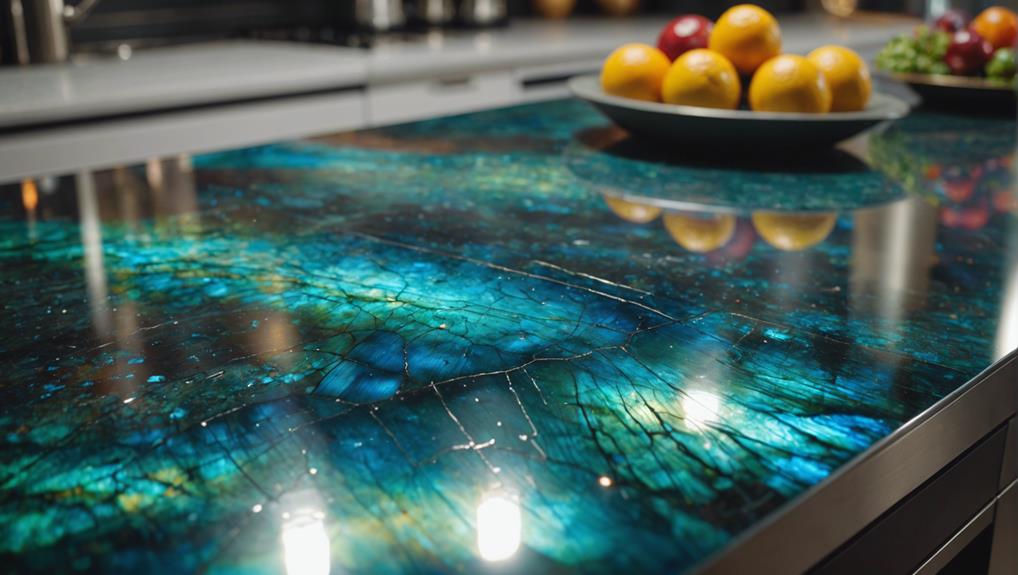
You’re about to discover the fascinating world of labradorite countertop prices.
As you explore this unique stone option, you’ll find that costs typically range from $200 to $300+ per square foot installed.
Your final price will depend on factors like the stone’s quality, pattern, and your chosen edge processing, so it’s worth comparing labradorite to other high-end materials to confirm you’re making the best choice for your kitchen.
Price Range per Square Foot
The average cost for labradorite countertops ranges from $200 to $300+ per square foot, with installation prices typically falling between $6,000 and $12,000+ for a standard kitchen. You’ll find that labradorite, a semi-precious gemstone often referred to as blue granite labradorite, offers a unique natural stone option for your countertops.
When comparing labradorite countertop prices to other materials, you’ll notice it’s on the higher end. Here’s a quick comparison:
| Material | Low-End ($/sq ft) | Mid-Range ($/sq ft) | High-End ($/sq ft) |
|---|---|---|---|
| Labradorite | $200 | $250 | $300+ |
| Quartz | $50 | $75 | $100 |
| Granite | $40 | $60 | $100 |
As you can see, labradorite is a premium choice. The cost per square foot can vary based on factors like slab quality, thickness, and finish. You’ll find that low-end prices start around $200, while high-end options can exceed $300 per square foot. Remember, the size of your kitchen and the square footage needed will substantially impact the final price. Don’t forget to factor in additional costs like removal of existing countertops and installation of sinks or cooktops.
Factors Influencing Cost
Several key factors influence the average cost of labradorite countertops, ranging from $200 to $300+ per square foot installed. The quality and uniqueness of the stone play a significant role in determining the price. A labradorite slab with a stunning pattern or rare coloration can command a higher price, sometimes reaching $180+ per square foot for the material alone.
The size of your kitchen also impacts the overall cost of labradorite countertops. Larger spaces require more material and labor, which can drive up the price. Don’t forget to factor in additional expenses like removing existing countertops, installing sinks and cooktops, and any necessary plumbing or electrical work.
When comparing labradorite to other stone countertops like granite slabs, you’ll find that natural labradorite often falls on the higher end of the price spectrum. However, many homeowners find the investment worthwhile for the luxurious aesthetic it brings to their kitchen.
To get the most accurate estimate for your labradorite countertop cost, it’s best to provide detailed measurements and specifications to your chosen supplier or installer.
Comparison With Other Materials
When comparing labradorite countertops to other popular materials, you’ll find they’re generally priced at the higher end of the spectrum, ranging from $200 to $300+ per square foot installed.
This puts them in a similar price bracket to high-end granite, but they’re often more expensive than mid-range granite or quartz options.
If you’re torn between labradorite and marble, consider that while labradorite comes with a higher price tag, it offers better durability and resistance to etching. In the long run, this could make it a smarter investment for your kitchen.
For those eyeing soapstone or slate, labradorite will set you back more. However, you’re paying for that stunning, iridescent appearance that can transform your kitchen into a work of art.
It’s like choosing between a reliable sedan and a luxury sports car – both will get you there, but one does it with style.
On the flip side, if you’re considering exotic natural stones like jade or onyx, labradorite actually becomes the budget-friendly option. It offers a similar high-end look without the eye-watering price tag of $500+ per square foot.
Factors Affecting Labradorite Costs
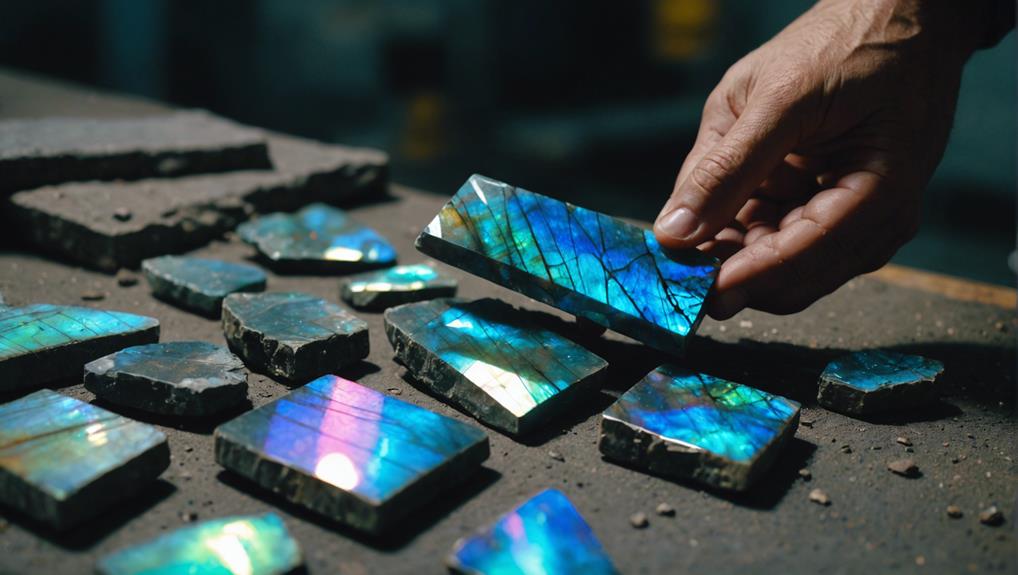
When you’re considering labradorite countertops, you’ll find that several factors influence their cost.
The quality of the stone and its unique pattern play a significant role, as does the size and thickness of the slab you choose.
Additionally, the complexity of the edge profile you select can impact the final price, with more intricate designs typically costing more.
Stone Quality and Pattern
The quality and pattern of labradorite play a vital role in determining its cost for countertops. When you’re considering this stunning natural granite for your kitchen, you’ll find that high-quality labradorite stones with vibrant colors and minimal imperfections command higher prices. It’s like choosing a piece of art for your home – the more striking the stone, the more you’ll invest.
The pattern of your labradorite countertop can greatly impact its value. Imagine a blue granite labradorite countertop with intricate swirls of gold and blue flashes – it’s bound to cost more than a simpler design. The phenomenon known as labradorescence, which creates that mesmerizing shimmering effect, is particularly prized. The more intense the labradorescence, the higher the price tag.
Stone quality isn’t just about looks, though. Thicker slabs of labradorite are generally more expensive, as they offer greater durability and a more luxurious appearance. And if you’re after a specific pattern or quality that’s rare or difficult to source, be prepared for a steeper cost. After all, you’re not just buying a countertop; you’re investing in a unique piece of nature’s artistry.
Slab Size and Thickness
Beyond pattern and quality, the size and thickness of your labradorite slab substantially impact its cost. When you’re planning your kitchen renovation, remember that larger slabs of labradorite stone will naturally come with a higher price tag.
It’s not just about square footage, though. The thickness of your countertop plays a vital role in both aesthetics and durability.
Standard thicknesses for labradorite countertops range from 2 cm to 3 cm, with thicker slabs generally commanding higher prices. But thicker doesn’t always mean better. Sometimes, a thinner slab can create a sleek, modern look that’s just as stunning.
Your kitchen’s layout will also influence the size of the slab you’ll need. Irregular shapes or multiple cutouts for sinks and appliances might require a larger piece of stone to accommodate these features.
And don’t forget about those eye-catching waterfall edges! They’re beautiful, but they’ll require more material and craftsmanship, which can bump up the price.
Edge Profile Complexity
The edge profile you choose for your labradorite countertop can substantially influence its overall cost. When selecting this stunning natural stone for your kitchen, it’s important to weigh how different edge profiles impact both aesthetics and price.
Standard straight edges are typically the most budget-friendly option, starting at around $200 per square foot. However, if you’re looking to add a touch of elegance to your blue granite countertops, more intricate profiles like ogee or dupont can elevate the look – but they’ll also raise the price to $300 or more per square foot.
The impact of edge profiles on your labradorite countertops can be broken down as follows:
- Complexity increases fabrication time and labor costs
- More intricate edges require additional expertise
- Installation costs may rise with complex profiles
- Decorative edges can boost overall price by up to 20%
Keep in mind that while a straight edge might be cost-effective, a slightly rounded eased edge ($220/sq ft) or a half bevel edge ($250/sq ft) can add a subtle sophistication to your stone countertops. Ultimately, the edge profile you select will contribute to the unique character of your labradorite kitchen, balancing beauty with your budget.
Comparing Labradorite to Other Materials
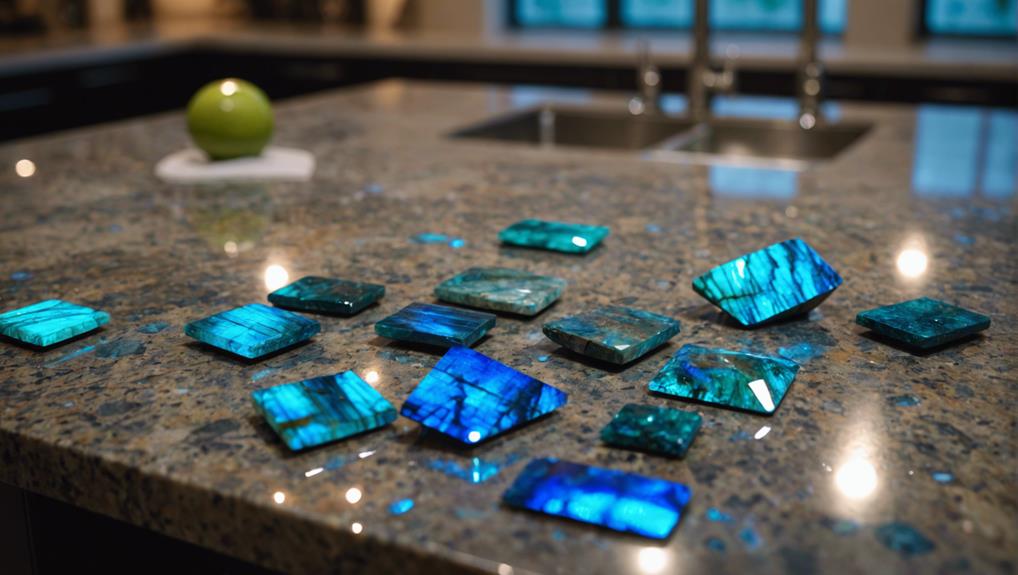
When considering labradorite countertops, you’ll want to weigh how they stack up against other popular materials.
You’ll find that labradorite’s price point is higher than many alternatives, but it offers unique aesthetic appeal that’s hard to match.
Let’s explore how labradorite compares to other options with regard to cost, durability, maintenance, and visual impact to help you make an informed decision for your kitchen.
Price Range Comparison
Compared to other popular countertop materials, labradorite stands out as a premium option, with prices ranging from $200 to $300+ per square foot. This puts it in the same league as high-end granite and marble countertops, known for their luxurious appeal. However, you’ll find that labradorite offers a unique, iridescent appearance that can truly set your kitchen apart.
When you’re considering your options, it’s helpful to compare labradorite to other materials:
- Quartz countertops: A more budget-friendly choice at $40 to $100 per square foot
- Laminate countertops: The most economical option, costing $10 to $30 per square foot
- Marble countertops: Comparable to labradorite, ranging from $150 to $300 per square foot
- Granite countertops: Typically $40 to $100 per square foot, with high-end options reaching $200
While labradorite countertops cost more than some alternatives, they offer a stunning visual impact that can increase your property’s value. It’s like having a piece of art in your kitchen that you can use every day. If you’re looking for something truly special and don’t mind investing in your home’s aesthetic, labradorite might just be the perfect choice for you.
Durability and Maintenance
Durability and maintenance considerations play a crucial role in your decision to invest in labradorite countertops.
Labradorite ranks 6 to 6.5 on the Mohs Hardness Scale, making it a durable choice for your kitchen. While it’s slightly softer than granite, it outperforms marble in scratch and heat resistance.
However, like any natural stone, it requires some TLC.
To keep your labradorite countertops looking their best, you’ll need to seal them regularly. This protective layer helps ward off stains from acidic substances that might otherwise leave their mark.
Imagine spilling red wine on your beautiful stone table – with proper sealing, you can avoid a potential disaster!
Maintenance is similar to granite countertops: a gentle cleaning with mild soap and water will do the trick.
Just remember to steer clear of abrasive materials that could scratch the surface. While labradorite is tough, it’s not invincible.
It may chip more easily than harder stones, so treat it with care.
With proper maintenance, your labradorite countertops will continue to dazzle for years to come, turning your kitchen into a showstopper.
Aesthetic Appeal Differences
You’ll be hard-pressed to find a countertop material that rivals labradorite’s unique aesthetic appeal. This natural stone boasts an iridescent quality that sets it apart from more common options like granite or marble. When light hits the surface of labradorite countertops, you’ll witness a mesmerizing display of shifting colors, ranging from deep blues to vibrant greens and even flashes of gold.
Unlike the static appearance of quartz or concrete, labradorite offers a dynamic visual experience. Its base color is typically a medium to dark gray, providing a neutral backdrop. The stone’s translucency varies, adding depth and intrigue to its appearance. Each slab has a unique pattern, ensuring your countertop is one-of-a-kind. The material’s natural origin gives it an organic feel that synthetic options can’t match.
Whether you’re considering blue labradorite granite or stone blue granite labradorite for your table tops, you’re choosing a material that’s sure to be a conversation starter. The aesthetic appeal of labradorite stone goes beyond mere functionality; it transforms your kitchen into a work of art. While other materials might fade into the background, labradorite countertops command attention and admiration, making them a standout choice for homeowners looking to create a truly distinctive space.
Installation Complexity Analysis
Installing labradorite countertops presents unique challenges that set it apart from other popular materials regarding complexity and expertise required. You’ll find that labradorite stone demands more attention and skill than its counterparts like granite or marble. The iridescent properties and delicate flecks of this handmade gemstone necessitate specialized cutting and polishing techniques, making the installation process more intricate.
Here’s a comparison of installation complexity for different countertop materials:
| Material | Complexity | Special Considerations |
|---|---|---|
| Labradorite | High | Delicate cutting, polishing |
| Granite | Medium | Heavier, less prone to chips |
| Quartz | Low | Pre-fabricated, quick install |
When you’re planning a labradorite bathroom or kitchen, keep in mind that the size and shape of the slab can further complicate the installation. Larger pieces or complex shapes require more time and expertise to install correctly. Due to labradorite’s tendency to chip more easily than granite, installers must take extra precautions during fabrication and installation. These factors contribute to a 10-20% increase in overall cost compared to other materials, reflecting the need for specialized labor and equipment.
Installation and Labor Expenses
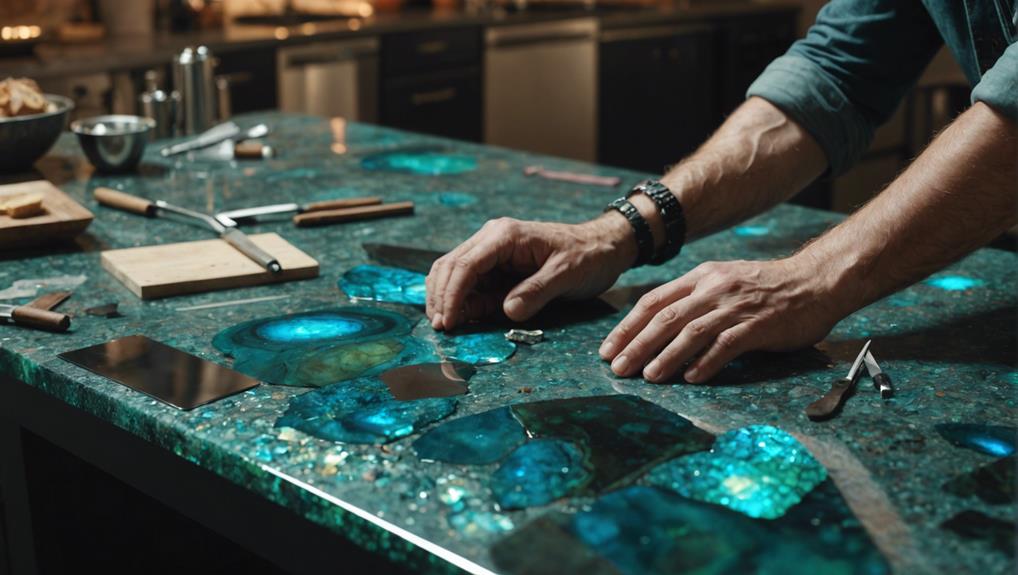
When considering labradorite countertops, you’ll need to factor in several installation and labor expenses that can substantially impact the overall cost. The process of transforming those stunning labradorite slabs into your dream kitchen countertops involves more than just the material itself.
Labor expenses can account for 30% to 50% of your total bill, with an average cost of $20 to $40 per square foot. Fabrication, which involves cutting and shaping the labradorite slabs, can add $1,000 to $2,000 to your installation cost. Additional work, such as plumbing and electrical adjustments, might set you back another $1,000 to $2,000.
Professional installation is essential for a high-quality result. You’re looking at a total installation cost ranging from $3,000 to $6,000 or more, depending on your kitchen’s size and the project’s complexity. It’s like putting together an intricate puzzle – each piece needs to fit perfectly, and that’s where the expertise of a professional installer comes in handy.
Maintenance and Long-Term Value
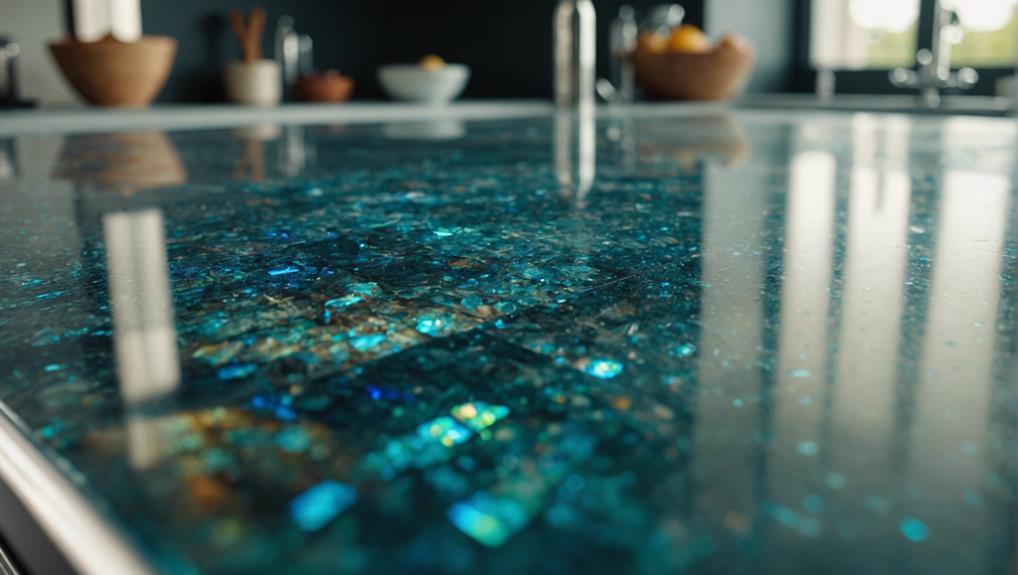
Labradorite’s long-term value hinges on proper maintenance, ensuring your countertop investment pays off for decades to come. With the right care, these stunning stone surfaces can last 20 to 30 years or more, making them a wise choice for your home decor. Let’s explore how to keep your labradorite countertops looking their best and maximize their value over time.
| Maintenance Task | Frequency | Cost |
|---|---|---|
| Sealing | Every 3-5 years | $100-$300 |
| Cleaning | Daily | Minimal |
| Repair | As needed | Varies |
| Refinishing | Occasional | Moderate |
| Professional inspection | Yearly | $100-$200 |
Regular sealing is essential for labradorite countertops. You’ll need to apply a sealant every 3 to 5 years, costing between $100 and $300 per application. This small investment protects your countertops from stains and keeps them looking pristine.
Daily cleaning is simple: use gentle products and avoid harsh chemicals. This routine care helps extend the life of your countertops and maintains their unique, iridescent beauty. While labradorite is durable, it can chip more easily than granite. Don’t worry, though – occasional repair and refinishing can keep your countertops looking good as new.
The long-term value of labradorite countertops is impressive. They can increase your property’s resale value by 10% to 15%, making them a smart investment for your home. With proper care, these stunning surfaces will remain a functional and beautiful feature in your kitchen or bathroom for decades, providing a lasting return on your investment.
Frequently Asked Questions
Is Labradorite Good for Countertops?
Labradorite can be an excellent choice for countertops.
You’ll love its stunning iridescent colors and unique shimmering qualities that’ll make your kitchen stand out.
It’s durable, ranking 6 to 6.5 on the Mohs Hardness Scale, so it’ll withstand daily use.
However, you’ll need to maintain it regularly with sealing and careful cleaning.
While it may chip more easily than granite, its luxurious appearance and potential to increase your property’s value make it a worthwhile investment for many homeowners.
How Much Does a Labradorite Slab Cost?
You’ll find that a labradorite slab’s cost can range from $60 to $180+ per square foot, but that’s just the starting point.
The price you’ll pay depends on various factors, including the slab’s color, pattern, and thickness.
If you’re eyeing a high-end piece with stunning iridescent hues, you might be looking at $300+ per square foot.
Remember, the rarer and more unique the pattern, the higher the price tag.
It’s an investment in beauty, after all!
What Is the Most Expensive Type of Countertop?
You might be surprised to learn that the most expensive type of countertop isn’t your typical granite or marble.
It’s actually rare, exotic stones like labradorite that take the crown.
These luxurious countertops can cost upwards of $400 per square foot, with some custom designs reaching a jaw-dropping $1,000 or more.
The price tag reflects their unique iridescent properties and scarcity.
If you’re dreaming of a truly one-of-a-kind kitchen, these high-end countertops might just be your ticket to opulence.
Which Stone Is Cheaper for Countertops?
When you’re shopping for countertops, you’ll find that granite and quartz are generally cheaper options than labradorite.
Granite can cost between $40 to $100 per square foot, while quartz ranges from $40 to $70.
If you’re on a tight budget, laminate countertops are the most affordable, starting at just $10 per square foot.
However, keep in mind that while these options are less expensive, they may not offer the same unique aesthetic as labradorite.
How Durable Is Labradorite?
Labradorite is quite durable, with a Mohs hardness rating of 6 to 6.5.
You’ll find it resistant to scratches and cracks, making it a solid choice for countertops.
It’s non-porous, which means it’s less likely to harbor bacteria or suffer water damage.
However, it may chip more easily than granite.
With proper care, including regular sealing, your labradorite countertop can maintain its beauty and functionality for years to come.
It’s a tough stone that’ll serve you well in the kitchen.
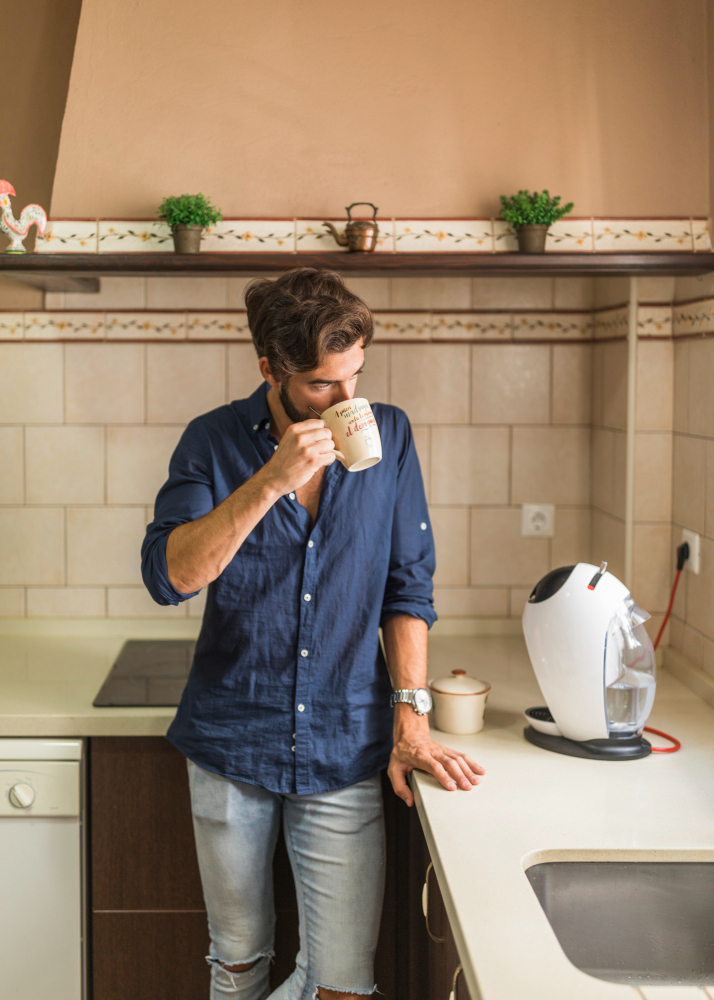
Jimmy Dean is a dedicated freelance writer who specializes in the home improvement sector. His passion for beautifying homes has been a lifelong pursuit. His expertise lies in the areas of cleaning, organizing, and executing home improvement projects. He uses his knowledge and skills to transform living spaces into aesthetically pleasing and functional homes.